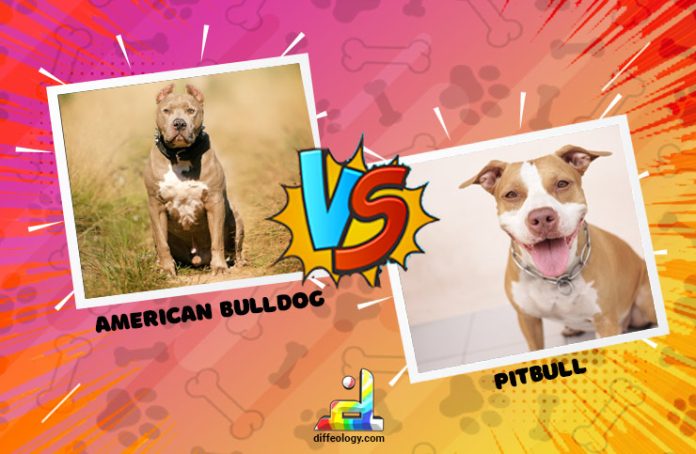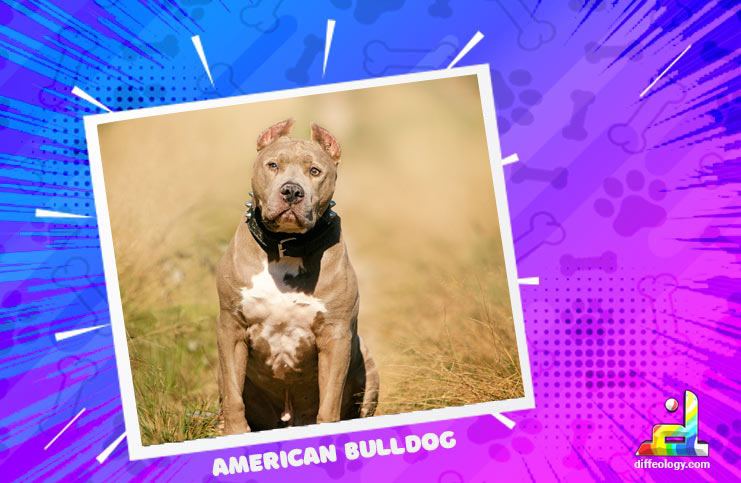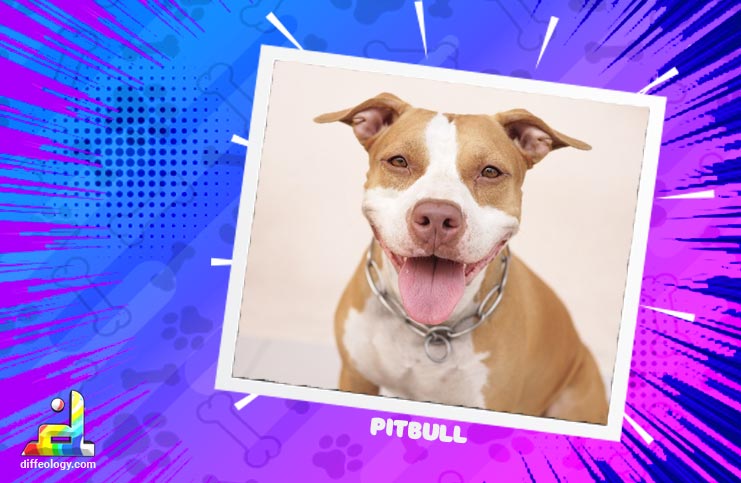There is a huge Difference Between American Bulldog And Pitbull as they are two distinct breeds of dogs, each with its own unique characteristics and history. The American Bulldog is known for its strong and muscular build, originally bred for farm work and loyal guardianship. On the other hand, the term “Pitbull” encompasses a group of breeds with athletic bodies and energetic personalities, initially developed for various tasks, including bull-baiting and companionship.
Both breeds have striking physical traits. American Bulldogs possess a wide chest, powerful legs, and a wrinkled face, while Pitbulls showcase their agility with defined muscles and short coats in a range of colors. In terms of temperament, American Bulldogs are protective and loyal, requiring early socialization for a friendly demeanor. Pitbulls, when properly trained and socialized, can be affectionate and energetic companions.
Understanding these breeds’ origins, appearances, and temperaments is crucial for responsible ownership and building positive relationships with these remarkable dogs.
Main Difference Between American Bulldog And Pitbull
The size of a pit bulldog compared to an American bulldog is one of the most noticeable differences between the two breeds. The American bulldog also outweighs the pit bull.
American Bulldog Vs. Pitbull
What is The American Bulldog?
The American Bulldog is a sturdy and muscular breed of dog. It’s known for its strong build and confident appearance. These dogs have a history rooted in working on farms and helping with various tasks.
One distinguishing attribute of the American Bulldog is its physical strength. They have a wide chest, muscular legs, and a big neck. Their coat may vary in many colors and patterns, and they frequently have a characteristic wrinkled face with a strong jaw.
Read Also: Difference Between Sheep and Lamb
With a heritage as a farm dog, American Bulldogs are recognized for their loyalty and protective nature. They can be friendly and affectionate with their families if properly trained and socialized. However, due to their history as working dogs, they may have a strong prey drive and need guidance in interacting with other pets. The American Bulldog stands as a robust and loyal breed. They flourish when they’re in an environment where they receive attention and join in activities with their human companions.
What is Pitbull?
The term “Pitbull” is often used to refer to a group of dog breeds rather than a single breed. Certain physical traits and attributes are shared by these breeds, which include the American Pit Bull Terrier, Staffordshire Bull Terrier, and American Staffordshire Terrier.
People acknowledge them for their strong, athletic bodies, and their impressive jaws are well-known. They have short coats that come in a variety of colors. These dogs are often praised for their energetic and lively nature.
Originally bred for activities like bull-baiting and later as farm and working dogs, Pitbulls can be affectionate and loyal companions. They are gregarious dogs who thrive on human connection and frequently build close bonds with their owners. Proper training and socialization from a young age are important to ensure their friendly and well-behaved nature around people and other pets.
It’s valuable to mention that Pitbulls have received considerable attention due to certain instances of aggression. However, it’s crucial to remember that a dog’s behavior is significantly shaped by how it’s raised and the surroundings it’s in. Responsible ownership, training, and positive interactions can help Pitbulls become wonderful and loving pets.
Difference Between American Bulldog And Pitbull in Detail
Origins and History:
The American Bulldog originated in the United States and was initially bred for farm work, like guarding livestock and catching wild hogs. They were originally developed as multipurpose companions during the colonial period.
“Pitbull” is often used to describe many canine breeds, including the American Pit Bull Terrier and the Staffordshire Bull Terrier. These breeds were developed in the UK in the 19th century for bull-baiting and later for dog fighting, although the American Pit Bull Terrier was bred for companion purposes in the United States.
Physical Appearance:
American Bulldogs are larger and more muscular dogs with a stocky build. Their heads are square, their muzzles are short, and their skin is loose and wrinkled. Their coats can be short or medium in length and come in various colors.
Pitbulls have a more compact and agile body with well-defined muscles. They possess a more rounded skull and a shorter, less pronounced muzzle. The coats on these animals are short and smooth and come in a rainbow of colors.
Temperament:
American Bulldogs are known for their loyal and protective nature. They are often affectionate with their families and can be great with children. However, they might be wary of strangers and require proper socialization.
Pitbulls are often friendly and enthusiastic dogs. They can be very loyal to their owners and can get along well with children if properly raised. Their temperament largely depends on their upbringing and socialization.
Energy Levels:
American Bulldogs have moderate energy levels. They enjoy physical activity but are also content with lounging around. Weight gain may be avoided with regular exercise.
Pitbulls tend to have higher energy levels. They require regular exercise and mental stimulation to prevent boredom and potential behavioral issues.
Trainability:
American Bulldogs are intelligent dogs but might display a stubborn streak. Consistent training with positive reinforcement works best for them.
Pitbulls are intelligent and eager to please. They respond well to positive training methods and can excel in various activities like obedience and agility.
Sociability with Other Dogs:
American Bulldogs can be selective in their doggy friendships. The importance of early socialization with other canines cannot be overstated.
Pitbulls can vary in their social behavior with other dogs. Proper socialization from a young age is essential to prevent aggressive tendencies.
Grooming Needs:
American Bulldogs have short coats that are relatively low-maintenance. Regular brushing helps control shedding and keeps their coat healthy.
Pitbulls also have short coats, making grooming fairly simple. Occasional brushing helps maintain their coat’s shine and removes loose hair.
Health Considerations:
American Bulldogs may be prone to certain health issues like hip dysplasia and skin problems. Regular vet check-ups are important to catch any potential problems early.
Hip dysplasia, allergies, and cardiac problems are just a few of the health issues that may affect Pitbulls. Responsible breeding practices and routine veterinary care can help manage these risks.
Protective Instincts:
American Bulldogs have a natural protective instinct, making them good guard dogs for their families and property.
Pitbulls can exhibit protective behaviors when their families are threatened, but their specific level of protective instinct can vary between individuals.
Legal Restrictions:
American Bulldogs usually don’t face the same level of legal restrictions as some breeds of Pitbulls. However, breed-specific legislation can impact them in certain areas.
Pitbull breeds often face breed-specific legislation and restrictions in various places due to their historical association with dog fighting.
Popularity:
American Bulldogs have gained popularity as versatile working dogs and loyal companions. Their fame has only risen with the passage of time.
While pit bulls and American pit bull terriers, in particular, have been popular household pets for decades, they have also been the subject of controversy owing to their controversial past.
Exercise Requirements:
American Bulldogs need regular exercise, but they are not as high-energy as some other breeds. Daily walks and playtime are usually sufficient.
Pitbulls have higher exercise needs. They thrive with daily physical activity, interactive play, and mental stimulation.
Lifespan:
The average lifespan of an American Bulldog is around 10 to 16 years, depending on their overall health and care.
Read Also: Difference Between Ticks and Fleas
Pitbulls generally have a lifespan of 12 to 16 years. Responsible breeding and proper healthcare contribute to their longevity.
Adaptability:
American Bulldogs can adapt well to different living environments, including both urban and rural settings.
Pitbulls are adaptable dogs that can live in various settings, but they do best in homes with responsible owners who understand their needs.
Ownership Requirements:
Owning an American Bulldog requires a commitment to training, socialization, and regular exercise. They thrive with owners who can provide leadership and structure.
Pitbull ownership demands responsible handling, early socialization, positive training methods, and a dedication to meeting their exercise and mental stimulation needs.
Comparison Table “American Bulldogs Vs. Pitbulls”
| Origins and History: | Bred for farm work and companionship. | Developed for bull-baiting and later fights. |
| Physical Appearance: | Larger, muscular, square head. | Compact, agile, rounded skull. |
| Temperament: | Loyal, protective, wary of strangers. | Friendly, loyal, depends on upbringing. |
| Energy Levels: | Moderate content with lounging. | Higher energy, need regular exercise. |
| Trainability: | Intelligent, stubborn streak. | Intelligent, responsive to positive training. |
| Sociability with Dogs: | Selective friendships, early socialization. | Varies, needs early socialization. |
| Grooming Needs: | Short coat, low-maintenance. | Short coat, simple grooming. |
| Health Considerations: | Hip dysplasia, skin issues. | Hip dysplasia, allergies, cardiac problems. |
| Protective Instincts: | Natural guard dogs. | Protective behavior varies with individual. |
| Legal Restrictions: | There are few restrictions, but they can be impacted. | Often face breed-specific legislation. |
| Popularity: | Versatile working dogs, rising fame. | Popular pets, controversy due to history. |
| Exercise Requirements: | Regular exercise, not high-energy. | Higher exercise needs, physical and mental. |
| Lifespan: | 10-16 years, depending on care. | 12-16 years, responsible care is important. |
| Adaptability: | Adaptable to different environments. | Adaptable, best with responsible owners. |
| Ownership Requirements: | Commitment to training, exercise. | Responsible handling, socialization, care. |
Pros and Cons
American Bulldog:
Pros:
- Versatile history as utility dogs, capable of various tasks.
- Loyalty and protective nature make them excellent family guardians.
- Affectionate and protective towards children, making them potential playmates and protectors.
- Moderate energy levels, adaptable to active play and relaxation.
- Intelligent and can learn tasks effectively with positive reinforcement.
- With proper socialization, they can form strong bonds with other dogs and animals.
- Short coat is relatively easy to maintain, requiring minimal grooming.
- Regular veterinary check-ups can catch potential health issues early.
- Natural protective instincts can provide security to the family.
- Generally less affected by breed-specific legislation in comparison to Pitbulls.
- Growing popularity reflects their versatility and appealing traits.
Cons:
- Protective instincts might lead to caution around strangers.
- Require early socialization to prevent overprotective behaviors.
- Wariness with strangers might require careful socialization to prevent aggression.
- Insufficient exercise can lead to weight gain and related health issues.
- A stubborn streak might require patience and consistent training.
- Selectiveness with other dogs might necessitate early socialization efforts.
- Shedding requires regular brushing to manage loose hair.
- Predisposition to hip dysplasia and skin problems requires vigilance.
- Overprotective behavior might need to be managed to prevent aggression.
- Some regions may still impose restrictions based on appearance or behavior.
- Increased popularity can lead to irresponsible breeding.
- Inadequate exercise can hinder overall well-being.
- Genetic predisposition to certain health issues requires vigilant monitoring.
- Drastic changes in the environment might require additional adjustment time.
- Inadequate training or socialization can lead to behavioral challenges.
Pitbull Dog:
Pros:
- Adaptable and friendly temperaments in some individuals due to diverse history.
- Loyalty and affection towards families can create strong bonds.
- Friendly nature and potential for getting along well with children.
- Higher energy levels encourage active lifestyles and outdoor activities.
- Eager to please and quick learning ability, excelling in training activities.
- Early socialization can lead to positive interactions with other dogs.
- A short coat makes grooming straightforward and reduces matting.
- Responsible breeding practices and veterinary care can mitigate health risks.
- Protective behaviors can create strong bonds with owners.
- With responsible ownership and advocacy, perceptions and restrictions can change.
- Long history as a companion dog showcases positive qualities.
- Regular exercise supports physical and mental health.
- Responsible breeding and healthcare contribute to potential long life.
- Adaptable nature enables them to thrive in different settings.
- Responsible ownership can result in a loving and well-behaved companion.
Cons:
- Negative stereotypes due to the history of dog fighting.
- Impact of negative history on public perception and legal restrictions.
- Misconceptions about their appearance might lead to fear and prejudice.
- Poorly bred or untrained individuals might exhibit aggressive tendencies.
- Lack of socialization can result in dog aggression.
- Shedding can still occur, requiring occasional brushing.
- Genetic predisposition to certain conditions demands proactive healthcare.
- Misinterpretation of protective behavior can lead to misunderstandings.
- Breed-specific legislation can limit ownership options.
- Controversies surrounding history can impact reputation.
- Neglecting exercise needs can lead to restlessness and behaviors.
- Genetic factors and health risks demand proactive management.
- Sudden changes in routine or environment might affect behavior.
- Irresponsible ownership can contribute to negative stereotypes.
Table Showing American Bulldogs Vs. Pitbulls Pros and Cons
| Temperament | Loyalty, protective nature | Caution with strangers, overprotectiveness | Adaptable, friendly temperament | Negative history, fear, and prejudice |
| Family Bonds | Affectionate with children, protectors | Requires socialization to prevent aggression | Strong bonds, potential with children | Aggressive tendencies, dog aggression |
| Energy Levels | Moderate energy, adaptable lifestyle | Weight gain if not exercised enough | High energy, active lifestyle | Restlessness, behavioral issues |
| Training | Intelligent, effective learning | Stubbornness and consistent training are needed | Quick learners, eager to please | Misinterpretation of behavior |
| Socialization | Strong bonds with dogs through socialization | Selectiveness with dogs | Positive interactions with dogs | Dog aggression, lack of socialization |
| Grooming | Easy to maintain with a short coat | Shedding requires regular brushing | Simple grooming reduced matting | Shedding, occasional brushing |
| Healthcare | Regular check-ups for early problem detection | Predisposition to health issues | Responsible breeding, healthcare | Genetic risks proactive care needed |
| Protectiveness | Natural instincts provide security | Overprotectiveness needs management | Strong owner bonds, protective behaviors | Misunderstandings, negative reputation |
| Legal Issues | Less impacted by breed-specific legislation | Some regions still impose restrictions | Potential for change with advocacy | Limitations due to breed-specific laws |
| Popularity | Growing fame due to appealing traits | Potential for irresponsible breeding | Long history as companion, positive traits | Reputation controversies |
| Exercise | Regular exercise supports well-being | Inadequate exercise leads to weight gain | Active lifestyle, physical and mental | Restlessness, behavior problems |
| Longevity | Potential for long lifespan with care | Genetic factors require proactive management | Responsible care for potential long-life | Health risks, proactive healthcare |
| Adaptability | Adaptable to various environments | Adjustment required for drastic changes | Thrives in different settings | Behavioral changes due to the environment |
| Ownership | Commitment to training and exercise | Increased popularity can lead to irresponsible ownership | Loving companions with responsible ownership | Irresponsible ownership contributes to negative stereotypes |
Key Points Showing Difference Between American Bulldog And Pitbull
- Physical Appearance: American Bulldogs are larger and heavier, while Pitbulls are more compact and leaner.
- Head Shape: American Bulldogs have a broader head with a well-defined muzzle, while Pitbulls have a more streamlined head with a shorter muzzle.
- Muscle Mass: American Bulldogs often exhibit more muscle mass and a stockier build, whereas Pitbulls have a sleeker, athletic physique.
- Coat Variations: American Bulldogs come in a range of coat patterns, including solid colors, while Pitbulls typically have a shorter coat in various colors.
- Temperament: American Bulldogs are known for their loyalty and protectiveness, whereas Pitbulls are often friendly, energetic, and social with people.
- Energy Levels: American Bulldogs have moderate energy levels and can be calmer, while Pitbulls are generally more high-energy and require more exercise.
- Trainability: Both breeds can be trained well, but Pitbulls may be more eager to please, while American Bulldogs might display more independence.
- Guarding Instincts: American Bulldogs might have a stronger natural guarding instinct, making them good watchdogs, whereas Pitbulls may be more accepting of strangers.
- Size: American Bulldogs are usually larger and heavier, with males weighing between 70-120 pounds and females between 60-100 pounds. In contrast, Pitbulls are smaller, with males weighing around 35-60 pounds and females weighing 30-50 pounds.
- Ears: American Bulldogs can have a range of ear shapes, including rose ears (folded back), drop ears (hanging), or semi-pricked ears (partly erect). Pitbulls typically have small, rose-shaped ears that fold back.
- Jaw Strength: American Bulldogs often have a strong, powerful jaw, which is a trait that was historically bred for their working roles. Pitbulls also have strong jaws, but the American Bulldog’s jaw might be even more robust.
FAQs: American Bulldog Vs. Pitbull
Conclusion:
Both the American Bulldog and Pitbull breeds offer unique qualities that can make them wonderful companions when properly cared for and understood. The American Bulldog stands strong with its muscular build and protective instincts, making it a loyal guardian for families.
Their history as farm dogs has shaped their loving yet cautious nature, and with early socialization, they can form strong bonds with both people and other animals. So, now you can decide what to buy as you know the Difference Between American Bulldog And Pitbull.



